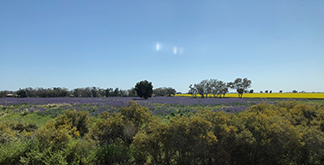
It’s fair to say that I have found the last seven months to be about the weirdest time in my life, and there has been a lot of uncertainty that has made it tough for many people.
In general, most beekeepers appear to have fared okay. They are accustomed to tough times due to the drought, bushfires and floods that directly impact their livelihood and the health of their bees. But beekeeping can be a very tough profession and some beekeepers are feeling the strain, with COVID-19 adding a further complication. So, if you’re doing it tough, don’t hesitate to ask for help.
In March, all face-to-face training by NSW Department of Primary Industries Tocal College was cancelled and it was not until September that it resumed. At the end of October, I organised and ran a bee biosecurity course in Tamworth with 19 beekeepers (mainly commercial). Beekeepers were very busy this spring, and it was good that they put aside two days (plus travel) to do the training. It’s a great way to develop professionally and improve the operation of your business. I encourage all beekeepers to do some bee biosecurity training to improve their general understanding of bee pests and diseases and how to manage them, to reduce the cost on their operation. You are never too big or too small to benefit from doing further training, and it may help you solve problems that affect your operation.
April was Sugar Shake Month. It was a timely reminder for anyone that had not yet completed their autumn brood checks and mite surveillance to do them. However, if hives are in an area that is quite cold in April, mite surveillance and brood checks can (and should) be done earlier. For many, early March is a great time to schedule the final brood inspections of the season to ensure hives can survive a long, cold winter.
On 1 July, the Australian Honeybee Industry Biosecurity Code of Practice (the Code) became a condition of registration in NSW. This means ALL beekeepers in NSW (including visitors from interstate) need to follow the guidelines set out in the Code. Victoria and South Australia also have the Code in place. In the four months leading up to July there was a lot of communication with beekeepers to make them aware of and prepare them for the changes. This included an article in The Land and a letter sent to the 10,000 registered beekeepers in NSW. This communication generated an extremely large amount of additional interest and I talked with a great number of beekeepers and could assist many with their record keeping, bee biosecurity training and other concerns about meeting their Code obligations. Since July the number of registered beekeepers in NSW has increased to 11,500, so this has increased enquiries about the Code even further.
August was almond pollination time, and in the lead-up to this event I helped many commercial beekeepers to meet their Code requirements, some for the first time. This was needed for them to get approval to enter Victoria and pollinate almonds there. Honey culture tests and bee biosecurity training were the main areas where help was needed. The EMAI lab saw a noticeable increase in honey culture tests requested in 2020 over previous years, which is a good sign.
|
|
 Large areas of both cultivated canola and noxious (bee friendly) weeds were prolific and helped beekeepers maintain healthy hives after almond pollination. Image: Rod Bourke
|
September and October were extremely busy for many commercial beekeepers, who were moving hives from almonds to canola, Patterson’s curse and other regional honey flows such as Mugga ironbark. This coincided with NSW DPI’s American foulbrood (AFB) awareness month and the majority of recreational beekeepers doing spring brood checks. Quite a lot of AFB was found, which was indicated in the newly launched “AFB near me” page on the NSW DPI website which listed six postcodes reporting AFB in July, 21 in both August and September, 24 in October and 27 in November.
The main enquiries from recreational beekeepers were about how to prepare a hive for euthanasia, the best ways to sterilise or destroy equipment, and how to implement a single hive barrier system. I also wrote articles for the NSW DPI Bee Biosecurity Newsletter on barrier systems (and related articles in the Honeybee News and Amateur Beekeepers Association newsletter) and one on the (mis)use of antibiotics to manage AFB (a practice which is illegal in NSW and much of Australia). Mark Page (BBO Surveillance) and I also did a video on inspecting a strong hive for AFB (they are often the first to get it if your bees have been robbing), another on chalkbrood and also our New Zealand varroa trip last year. All are currently being edited and will be published soon.
Along with other NSW DPI bee people, I did a Zoom presentation on barrier systems – a great way to reduce the spread of AFB – for the Tocal 2020 Virtual Beekeepers Field Day on 17 October. You can view the presentation here.
Even though a lot of people can’t wait until 2020 is over, many NSW beekeepers had quite a good spring in terms of rebuilding bee numbers and honey production. It’s hoped that hives will come through this period healthy and prepared for next year when opportunities may be less plentiful. To ensure this, all beekeepers should be following the Code and taking particular care to inspect hives thoroughly for disease, manage weak hives, prevent the opportunity for robbing (especially dead-outs, equipment and extracting operation) and do their twice yearly mite surveillance of all apiaries. If we all do the right thing, there will be less AFB about, and we will all be better off.